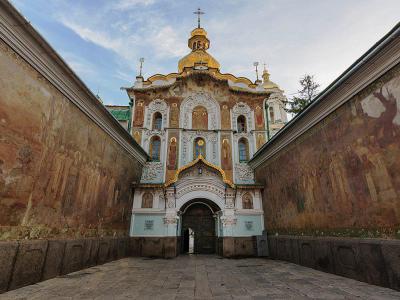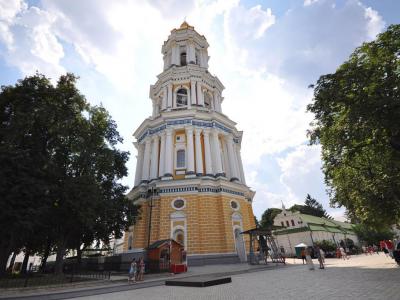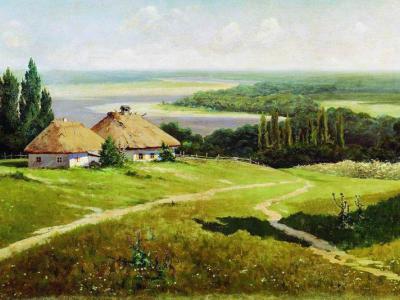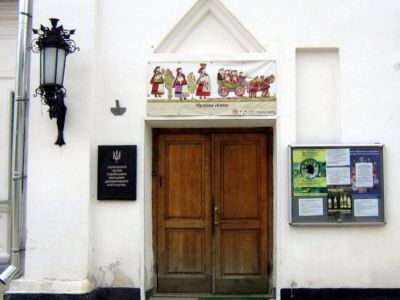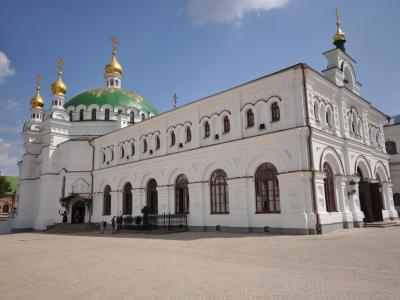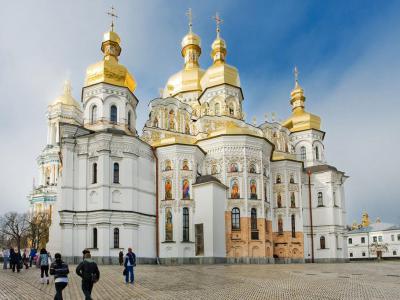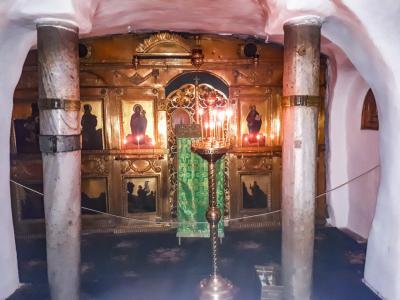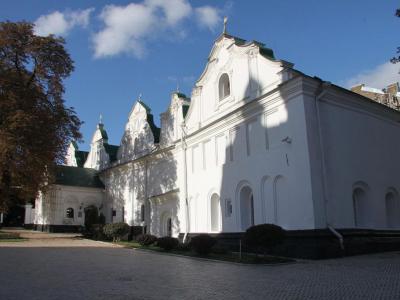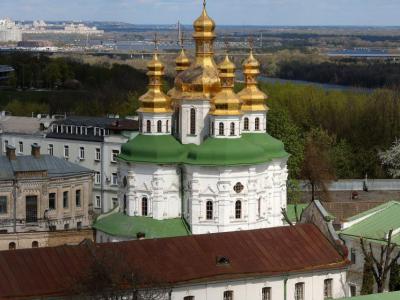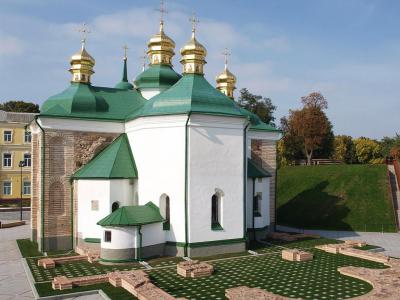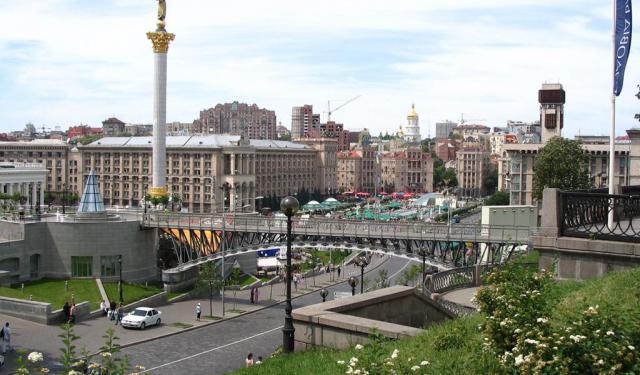Monastery of Kiev Caves Tour (Self Guided), Kiev
Some sources say that Kievo-Pecherskaya Lavra (Monastery of Kiev Caves Tour) was initiated in 1051, when Reverend Anthony arrived there. He, together with some of his followers, built an entire complex composed of caves and monasteries. When the monks moved to a monastery which is on Lavra's territory, the caves were utilized as burial sites. Nowadays it is included in the UNESCO World Heritage Site.
How it works: Download the app "GPSmyCity: Walks in 1K+ Cities" from Apple App Store or Google Play Store to your mobile phone or tablet. The app turns your mobile device into a personal tour guide and its built-in GPS navigation functions guide you from one tour stop to next. The app works offline, so no data plan is needed when traveling abroad.
Monastery of Kiev Caves Tour Map
Guide Name: Monastery of Kiev Caves Tour
Guide Location: Ukraine » Kiev (See other walking tours in Kiev)
Guide Type: Self-guided Walking Tour (Sightseeing)
# of Attractions: 10
Tour Duration: 1 Hour(s)
Travel Distance: 1.5 Km or 0.9 Miles
Author: Cathy
Sight(s) Featured in This Guide:
Guide Location: Ukraine » Kiev (See other walking tours in Kiev)
Guide Type: Self-guided Walking Tour (Sightseeing)
# of Attractions: 10
Tour Duration: 1 Hour(s)
Travel Distance: 1.5 Km or 0.9 Miles
Author: Cathy
Sight(s) Featured in This Guide:
- Gate Church of the Trinity
- Great Lavra Bell Tower
- Mykola Syadristy Micro-Miniatures Museum
- Museum of Ukrainian Decorative Folk Art
- Refectory Church
- Holy Dormition Cathedral
- Near Caves and Church of the Elevation of the Cross
- The Treasury of the National Museum of the History of Ukraine
- All-Saints Church
- Church of the Saviour at Berestove
1) Gate Church of the Trinity
The Gate Church of the Trinity is one of the notable structures within the Kyiv-Pechersk Lavra complex, positioned directly above the Holy Gates, the main entrance to the monastery. Built between 1106 and 1108, it is among the oldest surviving parts of the Lavra and one of the earliest examples of church architecture in Kyivan Rus.
Over the centuries, the church has been reconstructed several times, with its present appearance reflecting 18th-century Ukrainian Baroque influences layered over the original medieval structure.
The interior of the Gate Church of the Trinity is known for its detailed frescoes and painted vaults, created by Lavra artists in the early 18th century. The walls and ceilings depict biblical scenes, saints, and ornamental motifs, combining theological themes with artistic expression typical of the Baroque period.
Visitors can also see the richly decorated iconostasis, which separates the altar from the main nave, crafted with fine woodcarving and gilding.
Historically, the church served both a religious and symbolic function, marking the threshold between the secular world and the sacred space of the monastery. Pilgrims entering the Lavra traditionally paused here to offer prayers before proceeding further into the monastic grounds. Its location above the main gate gave it a special place in monastic life, as it overlooked the processions and ceremonies that took place in the courtyard below.
Over the centuries, the church has been reconstructed several times, with its present appearance reflecting 18th-century Ukrainian Baroque influences layered over the original medieval structure.
The interior of the Gate Church of the Trinity is known for its detailed frescoes and painted vaults, created by Lavra artists in the early 18th century. The walls and ceilings depict biblical scenes, saints, and ornamental motifs, combining theological themes with artistic expression typical of the Baroque period.
Visitors can also see the richly decorated iconostasis, which separates the altar from the main nave, crafted with fine woodcarving and gilding.
Historically, the church served both a religious and symbolic function, marking the threshold between the secular world and the sacred space of the monastery. Pilgrims entering the Lavra traditionally paused here to offer prayers before proceeding further into the monastic grounds. Its location above the main gate gave it a special place in monastic life, as it overlooked the processions and ceremonies that took place in the courtyard below.
2) Great Lavra Bell Tower
The Great Lavra Bell Tower is one of the central structures of the Kyiv-Pechersk Lavra complex and a prominent example of 18th-century architecture. Construction began in 1731 and was completed in 1745 under the direction of architect Johann Gottfried Schädel. At the time of its completion, the bell tower stood as one of the tallest buildings in Eastern Europe, measuring 96.5 meters in height. It served not only as a bell tower for the monastery but also as a symbol of the Lavra’s religious and cultural influence.
The tower consists of four tiers, each featuring classical architectural elements that reflect Baroque style blended with traditional Ukrainian design. Its lower levels are massive and sturdy, while the upper sections become increasingly light and decorative, creating a balanced vertical composition. The structure houses several bells, including one of significant size and weight, historically used to call monks and visitors to prayer. The golden dome crowning the tower adds to the visual harmony of the Lavra’s skyline.
Over the centuries, the Great Lavra Bell Tower has undergone various restoration and preservation efforts, particularly after damage from earthquakes and wars. Despite these challenges, it remains one of the best-preserved monuments from its era. The interior features a staircase leading to observation levels, offering panoramic views of the Lavra complex and the Dnipro River area.
The tower consists of four tiers, each featuring classical architectural elements that reflect Baroque style blended with traditional Ukrainian design. Its lower levels are massive and sturdy, while the upper sections become increasingly light and decorative, creating a balanced vertical composition. The structure houses several bells, including one of significant size and weight, historically used to call monks and visitors to prayer. The golden dome crowning the tower adds to the visual harmony of the Lavra’s skyline.
Over the centuries, the Great Lavra Bell Tower has undergone various restoration and preservation efforts, particularly after damage from earthquakes and wars. Despite these challenges, it remains one of the best-preserved monuments from its era. The interior features a staircase leading to observation levels, offering panoramic views of the Lavra complex and the Dnipro River area.
3) Mykola Syadristy Micro-Miniatures Museum
The Mykola Syadristy Micro-Miniatures Museum showcases the work of Ukrainian artist Mykola Syadristy, known for creating some of the world’s smallest and most detailed artworks. The museum’s collection includes sculptures, engravings, and other micro-miniatures that often require a microscope or magnifying glass to view properly, making the act of seeing the art an interactive part of the experience.
Among the museum’s notable pieces are a golden chessboard on a pinhead, a caravan of golden camels in the eye of a needle, and the world’s smallest book at just 0.6 mm, featuring illustrations and poems by Taras Shevchenko.
Each piece reflects extraordinary precision and creativity, offering visitors insight into the painstaking techniques used to create art on such a tiny scale.
Visitors often have the opportunity to use microscopes to examine the miniatures up close, which is considered an essential part of the museum experience.
Some travelers also mention that the artist himself, Mykola Syadristy, occasionally visits the museum, providing a chance to meet the creator and hear firsthand about his work and methods.
Among the museum’s notable pieces are a golden chessboard on a pinhead, a caravan of golden camels in the eye of a needle, and the world’s smallest book at just 0.6 mm, featuring illustrations and poems by Taras Shevchenko.
Each piece reflects extraordinary precision and creativity, offering visitors insight into the painstaking techniques used to create art on such a tiny scale.
Visitors often have the opportunity to use microscopes to examine the miniatures up close, which is considered an essential part of the museum experience.
Some travelers also mention that the artist himself, Mykola Syadristy, occasionally visits the museum, providing a chance to meet the creator and hear firsthand about his work and methods.
4) Museum of Ukrainian Decorative Folk Art
The National Museum of Ukrainian Folk Decorative Art preserves and presents the rich traditions of Ukrainian crafts. While its origins trace back to the late 19th century, the museum became an independent institution in 1964 and was granted national status in 2010.
Its collections include textiles, ceramics, woodwork, metalwork, folk paintings, and other traditional crafts from regions across Ukraine, highlighting both everyday objects and ceremonial pieces.
The museum is located within the grounds of the Kyiv-Pechersk Lavra, a historic monastery complex. Visitors enter the Lavra to access the museum, which is set among landscaped gardens and historic buildings.
Exhibits are arranged to showcase the regional variety of Ukrainian decorative arts, with information on the techniques and cultural significance behind each object, from embroidered clothing to intricately painted Easter eggs (also known as pysanky).
In addition to its permanent collections, the museum hosts temporary exhibitions, workshops, and demonstrations. Visitors can observe artisans at work and learn about traditional methods, making the experience interactive and offering insight into how these cultural practices have been preserved through generations.
Its collections include textiles, ceramics, woodwork, metalwork, folk paintings, and other traditional crafts from regions across Ukraine, highlighting both everyday objects and ceremonial pieces.
The museum is located within the grounds of the Kyiv-Pechersk Lavra, a historic monastery complex. Visitors enter the Lavra to access the museum, which is set among landscaped gardens and historic buildings.
Exhibits are arranged to showcase the regional variety of Ukrainian decorative arts, with information on the techniques and cultural significance behind each object, from embroidered clothing to intricately painted Easter eggs (also known as pysanky).
In addition to its permanent collections, the museum hosts temporary exhibitions, workshops, and demonstrations. Visitors can observe artisans at work and learn about traditional methods, making the experience interactive and offering insight into how these cultural practices have been preserved through generations.
5) Refectory Church
The Refectory Church, part of the Kyiv-Pechersk Lavra complex, was built between 1893 and 1895 to replace earlier structures that served the monastic community.
Designed by architect Vladimir Nikolayev, the church was constructed in a Neo-Byzantine style, reflecting late 19th-century architectural trends while maintaining continuity with the spiritual and communal functions of the Lavra. It was intended to serve both as a place of worship and as a refectory, where monks could gather for meals and religious observances.
The interior of the church features frescoes, icons, and decorative elements typical of Neo-Byzantine design. Its spacious layout accommodates both liturgical ceremonies and communal gatherings, illustrating how architecture was adapted to meet the practical and spiritual needs of the monastic community.
Visitors can explore the detailed artwork and the functional design that harmonizes religious practice with daily life in the monastery.
Throughout its history, the Refectory Church has been maintained and restored to preserve its architectural and artistic features. It provides insight into monastic life in Kyiv during the late 19th and early 20th centuries.
Designed by architect Vladimir Nikolayev, the church was constructed in a Neo-Byzantine style, reflecting late 19th-century architectural trends while maintaining continuity with the spiritual and communal functions of the Lavra. It was intended to serve both as a place of worship and as a refectory, where monks could gather for meals and religious observances.
The interior of the church features frescoes, icons, and decorative elements typical of Neo-Byzantine design. Its spacious layout accommodates both liturgical ceremonies and communal gatherings, illustrating how architecture was adapted to meet the practical and spiritual needs of the monastic community.
Visitors can explore the detailed artwork and the functional design that harmonizes religious practice with daily life in the monastery.
Throughout its history, the Refectory Church has been maintained and restored to preserve its architectural and artistic features. It provides insight into monastic life in Kyiv during the late 19th and early 20th centuries.
6) Holy Dormition Cathedral (must see)
The Holy Dormition Cathedral is one of the most significant and historic churches within the Kyiv-Pechersk Lavra complex, a site that has been a spiritual center of Eastern Orthodox Christianity for nearly a millennium.
Its construction began between 1073 and 1078 under the guidance of Abbot Theodosius, a key figure in the development of monastic life in Kyivan Rus’. From the outset, the cathedral served not only as a place of worship but also as a cultural and religious hub, drawing pilgrims from across Eastern Europe and playing a central role in the spiritual life of the monastery.
Dedicated to the Dormition of the Virgin Mary, a theme of deep significance in Orthodox tradition, the cathedral also functioned as a burial site for prominent religious figures, reinforcing its role as the heart of the Lavra’s monastic and devotional life.
Architecturally, the cathedral combined the Byzantine-inspired cross-in-square plan with local building techniques, featuring a large central dome, vaulted ceilings, and originally, walls adorned with vivid frescoes and icons depicting biblical scenes and saints. Over the centuries, it endured multiple reconstructions due to fires, invasions, and natural decay, each period leaving traces of historical and cultural significance.
Tragically, on November 3, 1941, the cathedral was almost completely destroyed—not by invading German forces as Soviet propaganda later claimed, but by retreating Soviet troops. Following their scorched-earth strategy, the Soviets planted remotely-controlled explosives throughout Kyiv, targeting cultural and religious landmarks.
Reconstruction of the cathedral began in the late 20th century, and it was fully restored and re-consecrated in 2000.
Its construction began between 1073 and 1078 under the guidance of Abbot Theodosius, a key figure in the development of monastic life in Kyivan Rus’. From the outset, the cathedral served not only as a place of worship but also as a cultural and religious hub, drawing pilgrims from across Eastern Europe and playing a central role in the spiritual life of the monastery.
Dedicated to the Dormition of the Virgin Mary, a theme of deep significance in Orthodox tradition, the cathedral also functioned as a burial site for prominent religious figures, reinforcing its role as the heart of the Lavra’s monastic and devotional life.
Architecturally, the cathedral combined the Byzantine-inspired cross-in-square plan with local building techniques, featuring a large central dome, vaulted ceilings, and originally, walls adorned with vivid frescoes and icons depicting biblical scenes and saints. Over the centuries, it endured multiple reconstructions due to fires, invasions, and natural decay, each period leaving traces of historical and cultural significance.
Tragically, on November 3, 1941, the cathedral was almost completely destroyed—not by invading German forces as Soviet propaganda later claimed, but by retreating Soviet troops. Following their scorched-earth strategy, the Soviets planted remotely-controlled explosives throughout Kyiv, targeting cultural and religious landmarks.
Reconstruction of the cathedral began in the late 20th century, and it was fully restored and re-consecrated in 2000.
7) Near Caves and Church of the Elevation of the Cross
The Near Caves are part of the historic Kyiv-Pechersk Lavra and were founded in 1051 by Saint Anthony, who also appointed the first abbot of the monastery. Unlike living quarters, the caves primarily served as an underground necropolis and space for cave churches.
The labyrinth of interconnected corridors and chambers includes three underground churches: the Church of Saint Anthony, the Church of Saint Barlaam, and the Church of the Presentation of the Virgin. Visitors can view religious relics, preserved remains of monks, and centuries-old artifacts that reflect the spiritual life of the monastic community.
Above the caves stands the Church of the Elevation of the Cross, constructed between 1700 and 1704. The church is notable for its surviving carved icons from 1769 and for its Neoclassical-style brother’s cells built in the 1830s. The church historically served the monks associated with the Near Caves and continues to host religious services, maintaining its connection to the Lavra’s spiritual traditions.
Exploring the Near Caves allows visitors to see how monastic burial practices and religious worship were combined in a subterranean environment.
The underground churches, relics, and preserved architecture provide insight into the religious, cultural, and artistic history of Kyiv over nearly a millennium.
The labyrinth of interconnected corridors and chambers includes three underground churches: the Church of Saint Anthony, the Church of Saint Barlaam, and the Church of the Presentation of the Virgin. Visitors can view religious relics, preserved remains of monks, and centuries-old artifacts that reflect the spiritual life of the monastic community.
Above the caves stands the Church of the Elevation of the Cross, constructed between 1700 and 1704. The church is notable for its surviving carved icons from 1769 and for its Neoclassical-style brother’s cells built in the 1830s. The church historically served the monks associated with the Near Caves and continues to host religious services, maintaining its connection to the Lavra’s spiritual traditions.
Exploring the Near Caves allows visitors to see how monastic burial practices and religious worship were combined in a subterranean environment.
The underground churches, relics, and preserved architecture provide insight into the religious, cultural, and artistic history of Kyiv over nearly a millennium.
8) The Treasury of the National Museum of the History of Ukraine
The Treasury of the National Museum of the History of Ukraine, formerly known as the Ukrainian Museum of Historical Treasures, is located within the grounds of the Kyiv-Pechersk Lavra, one of Kyiv’s most important historical sites. The museum’s origins date back to 1963, when it was established as a special department called the “Golden Storehouse,” and it officially opened to the public in 1969. Since its founding, the Treasury has served as a center for preserving and showcasing Ukraine’s rich tradition of metal art, featuring items made of gold, silver, and precious stones.
The collection spans more than two millennia, illustrating the history of craftsmanship and cultural exchange on Ukrainian territory. Among its most notable exhibits are the gold ornaments, weaponry, and decorative objects uncovered in Scythian burial mounds dating from the 7th to 3rd centuries BCE. The museum also houses artifacts from the Sarmatian, Kievan Rus, and medieval periods, providing insight into the artistic and social life of these historical eras.
In recent years, the Treasury has expanded its collection to include cultural artifacts that represent the broader diversity of Ukraine’s heritage. Visitors can see exhibits dedicated to Crimean Tatar culture, Jewish ceremonial silver, and other examples of regional craftsmanship that highlight the multicultural influences shaping Ukraine’s history.
The collection spans more than two millennia, illustrating the history of craftsmanship and cultural exchange on Ukrainian territory. Among its most notable exhibits are the gold ornaments, weaponry, and decorative objects uncovered in Scythian burial mounds dating from the 7th to 3rd centuries BCE. The museum also houses artifacts from the Sarmatian, Kievan Rus, and medieval periods, providing insight into the artistic and social life of these historical eras.
In recent years, the Treasury has expanded its collection to include cultural artifacts that represent the broader diversity of Ukraine’s heritage. Visitors can see exhibits dedicated to Crimean Tatar culture, Jewish ceremonial silver, and other examples of regional craftsmanship that highlight the multicultural influences shaping Ukraine’s history.
9) All-Saints Church
The All Saints Church, is a historic religious site located within the Kyiv-Pechersk Lavra complex. Built between 1696 and 1698 with support from Hetman Ivan Mazepa, the church exemplifies the Ukrainian Baroque architectural style common in the late 17th century.
It was constructed above the Economic Gate of the Lavra Monastery, blending both functional and spiritual purposes within the monastic ensemble.
The interior of the church features traditional religious artwork, including frescoes and an iconostasis, which reflect the artistic traditions of the time. Over the centuries, The All Saints Church has undergone several restorations, including significant efforts that began in the mid-20th century. These preservation activities have helped maintain the church’s structural integrity and the richness of its decorative elements.
As part of the larger Kyiv-Pechersk Lavra, a UNESCO World Heritage Site, the church is situated within a complex that has been an important center of Eastern Orthodox Christianity since the 11th century.
The Lavra’s long history as a cave monastery and its continued religious activity make the All Saints Church a meaningful stop for visitors interested in the spiritual and cultural heritage of the region.
It was constructed above the Economic Gate of the Lavra Monastery, blending both functional and spiritual purposes within the monastic ensemble.
The interior of the church features traditional religious artwork, including frescoes and an iconostasis, which reflect the artistic traditions of the time. Over the centuries, The All Saints Church has undergone several restorations, including significant efforts that began in the mid-20th century. These preservation activities have helped maintain the church’s structural integrity and the richness of its decorative elements.
As part of the larger Kyiv-Pechersk Lavra, a UNESCO World Heritage Site, the church is situated within a complex that has been an important center of Eastern Orthodox Christianity since the 11th century.
The Lavra’s long history as a cave monastery and its continued religious activity make the All Saints Church a meaningful stop for visitors interested in the spiritual and cultural heritage of the region.
10) Church of the Saviour at Berestove
The Church of the Saviour at Berestove is one of the oldest surviving churches in the region, located just outside the walls of the Kyiv-Pechersk Lavra complex. Its origins date back to the early 12th century, during the reign of Prince Volodymyr Monomakh.
The original structure was part of a princely estate and served as a burial place for members of the ruling dynasty. Over the centuries, the church has undergone numerous reconstructions, reflecting the architectural and historical changes that have shaped the city.
The current appearance of the church combines elements from several periods. After suffering damage during invasions and neglect, it was rebuilt in the 17th century under the patronage of the Lavra monks in a style that merged early Rus’ architecture with Ukrainian Baroque influences.
Inside, visitors can see fragments of ancient frescoes from the 12th century, uncovered during restoration work, alongside later decorative additions.
In 1640, the Church of the Saviour at Berestove became part of the Kyiv-Pechersk Lavra, contributing to the complex’s religious and historical importance. Its modest size contrasts with the grandeur of other Lavra buildings, yet it holds significant value for understanding the early development of local ecclesiastical architecture.
The original structure was part of a princely estate and served as a burial place for members of the ruling dynasty. Over the centuries, the church has undergone numerous reconstructions, reflecting the architectural and historical changes that have shaped the city.
The current appearance of the church combines elements from several periods. After suffering damage during invasions and neglect, it was rebuilt in the 17th century under the patronage of the Lavra monks in a style that merged early Rus’ architecture with Ukrainian Baroque influences.
Inside, visitors can see fragments of ancient frescoes from the 12th century, uncovered during restoration work, alongside later decorative additions.
In 1640, the Church of the Saviour at Berestove became part of the Kyiv-Pechersk Lavra, contributing to the complex’s religious and historical importance. Its modest size contrasts with the grandeur of other Lavra buildings, yet it holds significant value for understanding the early development of local ecclesiastical architecture.
Walking Tours in Kiev, Ukraine
Create Your Own Walk in Kiev
Creating your own self-guided walk in Kiev is easy and fun. Choose the city attractions that you want to see and a walk route map will be created just for you. You can even set your hotel as the start point of the walk.
Kiev Introduction Walking Tour
Kiev is a very old city. It was initiated approximately 1500 years ago. Since 1934, it was Soviet Ukraine's capital and remained the main city of the country with the collapse of the Soviet Union. Being one of the biggest cities in Europe, it has a very specific history, architecture and cultural life. One can never be bored in Kiev, as it has endless interesting and captivating places to... view more
Tour Duration: 2 Hour(s)
Travel Distance: 3.6 Km or 2.2 Miles
Tour Duration: 2 Hour(s)
Travel Distance: 3.6 Km or 2.2 Miles
Andriyivskyy Descent Walk
Andriyivskyy (Andrew's) Descent is a historic cobblestone street, running 720 meters (2,360 ft) downhill from the Upper (Old) Town of Kiev to the once commercial neighborhood of Podil (Lower Town), ending at Kontraktova Square.
According to a legend, there was once a sea where the Dnieper River now flows. When Saint Andrew, the Apostle came to Kiev and erected a cross on the spot where St... view more
Tour Duration: 1 Hour(s)
Travel Distance: 0.6 Km or 0.4 Miles
According to a legend, there was once a sea where the Dnieper River now flows. When Saint Andrew, the Apostle came to Kiev and erected a cross on the spot where St... view more
Tour Duration: 1 Hour(s)
Travel Distance: 0.6 Km or 0.4 Miles
Kiev's Architectural Jewels
Kiev is a city with such a wide diversity of architectural styles from various periods of time. The best European, Russian and Ukrainian architects and artists worked on the buildings of the capital of Ukraine. Some of the elements are absolutely unique and can be seen exclusively in Kiev. Some of the most famed architects who contributed to the city's beauty and originality are Vikentiy... view more
Tour Duration: 2 Hour(s)
Travel Distance: 4.1 Km or 2.5 Miles
Tour Duration: 2 Hour(s)
Travel Distance: 4.1 Km or 2.5 Miles
Useful Travel Guides for Planning Your Trip
Kiev Souvenirs: 12 Distinctively Ukrainian Products to Bring Home
In recent years, Ukraine has made the news rather distant from welcoming tourism. Still, despite some controversial publicity, the country - for the most part - continues normal life and retains its traditional hospitality. There are quite a few things in Kiev, distinctively Ukrainian, that a...
The Most Popular Cities
/ view all



